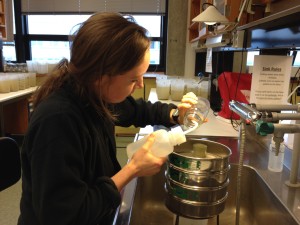Less than two weeks after arriving the port of Tromsø with G.O. Sars the ice2ice Team Jansen members started the comprehensive sedimentological analyses of the retrieved sediments form the Western Nordic Seas.
Focus are put on two 20 m long piston cores from the shelf outside Scoresbysund and the first results indicate that the selected cores cover ice2ice target intervals: the Eemian interglacial, Marine Isotope Stage 3 and the Holocene.

These cores are currently scanned at the University of Bergen using the X-ray fluorescence (XRF) method. Like on the cruise the team members are working in shifts at the XRF scanner in order to generate as much data as possible within a short time period. That approach will give indications about the elemental composition of the marine sediments and in combination with the existing data from onboard measurements of magnetic susceptibility we are able to develop initial age models for the cores. In which resolution these intervals are resolved in the equivalent cores is currently established by using oxygen isotope stratigraphy and radiocarbon based age determination.
Over the next few weeks the PhD students Evangeline and Henrik, as well as Ashley (Fulbright student) and the new Ice2ice master student Ida will be working in the sediment lab sampling the two piston cores. Sampling will be done at 5 cm intervals in 1/2 cm slices. These will be weighed, dried and sieved before being picked for various foraminifera to conduct isotope analysis. The analysis will help us construct past temperatures and help us to determine the age of the core when compared with isotope concentrations from ice cores. When the MIS3, and DO events are “located” in the core, we will sample the rest of the core in that time frame to conduct other multi-proxy analysis such as Mg/Ca on benthic foraminifera to capture past bottom water temperatures.
In addition to the lab work Henrik is currently working on a high-resolution sea ice record based on biomarkers in core MD99-2284 from the southern Norwegian Sea, which will cover at least two D-O cycles around DO 8 and 7. After having the first age models for our new cores, he will start to generate similar sea ice records for cores from the northern Denmark Strait and the East Greenland margin.
In-depth studies of tephra are conducted by Sarah and scheduled later this autumn. She is currently exploring how to utilize the Flow-cam at the new Earth Lab hosted by Dept. of Earth Science at UoB in order to establish a tephracronology in the Scoresbysund cores.
Want to know what is behind the numbers and curves?
The lab work is a crucial part of the ice2ice project providing us with the basis for our paleoclimatic reconstructions. All Ice2ice members are welcome to join or visit us at our laboratories for a day, a week or a month! Contact Jørund Strømsøe.